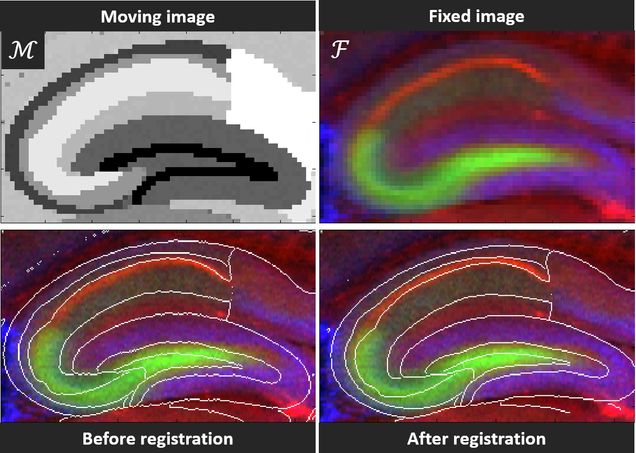Quantitative Analysis of Metallomic Images to Assess Traumatic Brain Injury
Team: A. Gaudreau-Balderrama, L. Goldstein, J. Konrad
Funding: NIH
Status: Completed (2012-2017)
Background: While an association between the tau protein neurodegenerative disease chronic traumatic encephalopathy (CTE) and traumatic brain injury (TBI) has been established, a direct causal relationship between TBI and the development of CTE is still being investigated. Previous work has shown evidence of acute microvasculopathy following TBI, consistent with the perivascular patterns of phosphorylated tau protein brain pathology in CTE.
Summary: The primary aim of this research is to develop image processing algorithms to quantitatively determine the link between TBI severity and CTE neuropathology, specifically looking at the role of blood-brain barrier (BBB) dysfunction following TBI. To address limitations associated with traditional neuropathological imaging modalities, a secondary aim is on developing methods for a novel application of metallomic imaging mass spectrometry (MIMS) to biological tissue. Unlike traditional modalities used to assess neuropathology, MIMS uses a mass spectrometer – an analytical instrument for analytical measurement of elements and isotopes with high dynamic range, sensitivity and specificity – as the imaging sensor to generate spatial maps with spectral (vector-valued) data per pixel. First, algorithms to evaluate traditional modalities, including high speed videography, fluorescent images, and macroscopic optical images, are described. Then, a complete processing pipeline is developed to support the acquisition, visualization and interpretation of MIMS data. A novel multi-modal and multi-channel image registration (MMMCIR) method is presented to establish correspondence between two images of arbitrary modality by using multivariate mutual information as a similarity metric. The MMMCIR method is used to automatically segment MIMS images of the mouse brain and systematically evaluate the levels of relevant elements and isotopes after experimental closed-head impact injury on the impact side (ipsilateral) and opposing side (contralateral) of the brain. This method quantifiably confirms observed differences in gadolinium levels for a cohort of images. Finally, MIMS images of human lacrimal sac biopsy samples were used for preliminary clinicopathological assessments, supporting the utility of the unique insights MIMS provides by correlating areas of inflammation to areas of elevated toxic metals. The image processing methods developed in this work were used to demonstrate the significant capabilities of MIMS and its role in enhancing our understanding of the underlying pathological mechanisms of TBI and other medical conditions.
Publications:
- C. A. Tagge, A. M. Fisher, O. V. Minaeva, A. Gaudreau-Balderrama, J. A. Moncaster, X.-L. Zhang, M. W. Wojnarowicz, N. Casey, H. Lu, O. N. Kokiko-Cochran, S. Saman, M. Ericsson, K. D. Onos, R. Veksler, V. V. Senatorov, Jr, A. Kondo, X. Z. Zhou, O. Miry, L. R. Vose, K. R. Gopaul, C. Upreti, C. J. Nowinski, R. C. Cantu, V. E. Alvarez, A. M. Hildebrandt, E. S. Franz, J. Konrad, J. A. Hamilton, N. Hua, Y. Tripodis, A. T. Anderson, G. R. Howell, D. Kaufer, G. F. Hall, K. P. Lu, R. M. Ransohoff, R. O. Cleveland, N. W. Kowall, T. D. Stein, B. T. Lamb, B. R. Huber, W. C. Moss, A. Friedman, P. K. Stanton, A. C. McKee, and L. E. Goldstein, “Concussion, microvascular injury, and early tauopathy in young athletes after impact head injury and an impact concussion mouse model,” Brain, p. awx350, Jan. 2018.
- A. Gaudreau-Balderrama, Methods and algorithms for quantitative analysis of metallomic images to assess traumatic brain injury. PhD thesis, Boston University, May 2017.
